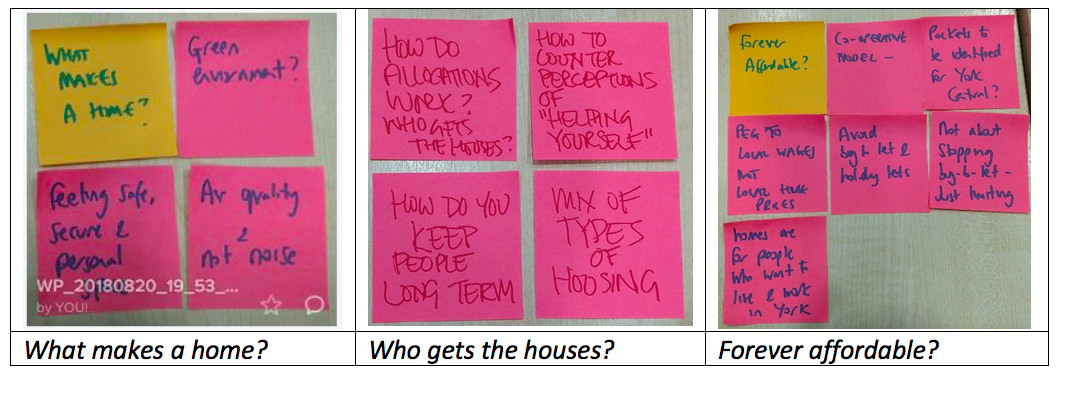Notes from meeting 20th August 2018
The purpose of the community-led housing event was to build on the interest identified during the Festival of York Central. The question of how to make homes on York Central not just affordable but forever affordable was explored during an event during the Festival and this – plus the two boards of post it notes in the exhibition – informed the first of the My York Central big ideas. It is also worth noting that Homes England are interested in supporting community-led housing.
We invited James Newton of YorSpace and Jimm Reed from Leeds Community Homes to join us to inform the discussions with their experience and expertise.
We began by seeking to refine the brief for York Central – and to explore the links between housing and other aspects of the site.
A number of strands of discussion developed, including:-
- Basic questions and answers – what does community-led housing provide? (Something different, but also the basics like a place which feels secure?)
- What is affordability, and who exactly is community-led housing providing for? (Who gets to live there, and does this include middle-earners who still need housing help?)
- How is long-term affordability ensured, and buy-to-lets and holiday-lets avoided? (Which led to a broader discussion of control and governance)
A number of questions led to discussion of the structure(s) that was required in order to provide what was wanted. For example:-

How to stop holiday lets and buy-to-lets?
This has been a recurrent question (from the start of the Festival of York Central) – we discussed a number of different models, but there seemed to be two basic approaches:-
- Co-operative or co-ownership models which retain overall control through overall ownership (as used by Yorspace with their Mutual Home Ownership Society).
- Covenents or other legal means to retain control when ownership is passed to others.
How to make sure people around the scheme are gaining from the scheme?
One of the ideas that came out of the Festival of York Central was of a social contract which provided benefits for residents outside York Central in return for any disruption or disbenefit which the development caused. How can Leeman Road Triangle share some of the benefits of the development – can two-way investment benefit both? How do you define the boundaries of the community? How wide should the “membership” be?
Could the whole of York Central be a Community Land Trust?
The role of a Community Land Trust (CLT) was explored. This provides for ownership of the land which means it can’t be disposed of without it being in the interests of the membership. Private housing could still be in there. Affordable housing could then be controlled as (for now at least) Community Land Trusts have exclusion from ‘right to buy’. The community land trust could be responsible for the green spaces – but would need income stream to do this.
This raises issues of service charges and stewardship.
It is very common to appoint a service company to do maintenance and receive service charges. It was noted that someone is going to be collecting service charges – could it be a community-led body where the money gets ploughed back into the community? This would then create long term stewardship. It was suggested that this could be on Garden City principles, so the community-led body might run commercial ventures so they have a revenue stream and that gets ploughed back in.
‘There is a difference between this and putting faith in a distant council by waiting for them to do something. In a community-led context, people can do it themselves’.
‘This is about York, taking back control’.
Community? Economy? Housing?
‘Community is about encouraging people – putting in encouragement for the things we call “community” to work?’
The discussion led on to making links between the previous event on community-led economic development and this conversation about community-led housing.
How can we develop the infrastructure that enables social and economic exchange to work (Phil has written a blog on this to bring this idea to life).
‘This goes beyond community-led housing and onto community-led living’
‘there is a strong consensus about some kind of Community Interest Company, that people on the site make the site’.
Next steps:
- Link together the community-led economic development ideas and community-led housing ideas
- Explore ways of setting up a clear vision
- Build a bigger network of people who might be interested in this.